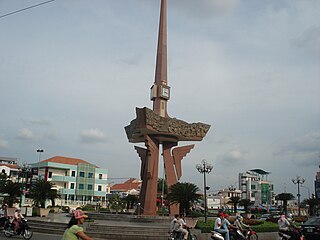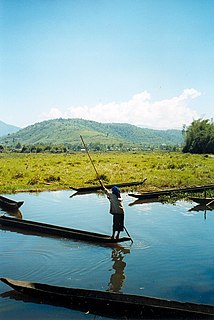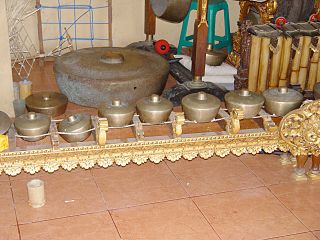
The Degar, also known as Montagnard, are the indigenous peoples of the Central Highlands of Vietnam. The term Montagnard means "people of the mountain" in French and is a carryover from the French colonial period in Vietnam. In Vietnamese, they are known by the term người Thượng (Highlanders)—this term now can also be applied to other minority ethnic groups in Vietnam or Người dân tộc thiểu số. Earlier they were referred to pejoratively as the mọi.

Gamelan Degung is a Sundanese musical ensemble that uses a subset of modified gamelan instruments with a particular mode of pelog scale. The instruments are manufactured under local conditions in towns in West Java such as Bogor. Degung music is often played at public gatherings in West Java, such as at local elections, as well as many other events. There is international interest in degung as well amongst communities in other countries interested in Indonesia and gamelan music.

Bình Dương is a province of Vietnam. It is located in the Southeast region of the country, immediately to the north of Ho Chi Minh City. The province was created from Sông Bé Province on January 1, 1997.

The Communist Party of Thailand was a communist party in Thailand active from 1942 until the 1990s.

Đắk Lắk is a province of Vietnam. It is located in Vietnam's Central Highlands, and is home to quite a few indigenous ethnic minorities, such as the Rade, the Jarai and the Mnong, among others.

Tây Nguyên, translated as Western Highlands and sometimes also called Central Highlands, is one of the regions of Vietnam. It contains the provinces of Đắk Lắk, Đắk Nông, Gia Lai, Kon Tum, Lâm Đồng.
The Bahnaric languages are a group of about thirty Austroasiatic languages spoken by about 700,000 people in Vietnam, Cambodia, and Laos. Paul Sidwell notes that Austroasiatic/Mon–Khmer languages are lexically more similar to Bahnaric and Katuic languages the closer they are geographically, independently of which branch of the family they belong to, but that Bahnaric and Katuic do not have any shared innovations that would suggest that together they form a branch of the Austroasiatic family, rather forming separate branches.

Human rights in Vietnam have long been a matter of much controversy between the Government of Vietnam and some international human rights organizations and Western governments, particularly that of the United States. Under the current constitution, the Communist Party of Vietnam is the only one allowed to rule, the operation of all other political parties being outlawed. Other human rights issues concern freedom of association, freedom of speech, and freedom of the press.
The Mnong language (Bunong:ឞូន៝ង) belongs to the Mon–Khmer language family. It is spoken by the different groups of Mnong in Vietnam and a Mnong group in Cambodia.
Traditional Vietnamese musical instruments are the musical instruments used in the traditional and classical musics of Vietnam. They comprise a wide range of string, wind, and percussion instruments, used by both the Viet (Kinh) majority as well as the nation's ethnic minorities.
The Pnong are an aboriginal Cambodian minority ethnic group. They are found primarily in Mondulkiri province of Cambodia. The Pnong is the largest indigenous highland ethnic group in Cambodia. They have their own language called Pnong, which belongs to Bahnaric branch of Austroasiatic languages. Majority of Pnong people are animists, but a minority of them follows Roman Catholicism and Theravada Buddhism. The Pnongs are considered as Khmer Loeu or Montagnard, which is the collective name given to the various indigenous ethnic groups residing in the highlands of Cambodia.
The đàn đá is a lithophone played by ethnic minority groups in the Central Highlands of Vietnam, in the provinces of Lâm Đồng, Đắk Nông, Đắk Lắk, Gia Lai, and Kon Tum. These provinces are also home of the space of Gong culture listed in UNESCO's World Heritage Site. The word đá means "stone" in Vietnamese, đàn is instrument. The term đàn đá is of recent origin among Vietnamese musicologists, it had also been referred to as a đàn goong, a Vietnamese gong.

The Rade are an Austronesian ethnic group of southern Vietnam.

A gong chime is a generic term for a set of small, high-pitched bossed pot gongs. The gongs are ordinarily placed in order of pitch, with the boss upward on cords held in a low wooden frame. The frames can be rectangular or circular, and may have one or two rows of gongs. They are played by one to four musicians, each using two padded sticks to strike them. They are an important instrument in a large number of Southeast Asian musical ensembles, such as Indonesian gamelan, Philippine kulintang, or Thai pi phat. For this reason, such ensembles are sometimes called "gong chime ensembles" or "gong chime orchestras," and the broad variety of music "gong chime music."
Georges Louis Condominas was a French cultural anthropologist. He is best known for his field studies of the Mnong people of Vietnam.
Stieng is the language of the Stieng people of southern Vietnam and adjacent areas of Cambodia, and possibly Laos. Along with Chrau and Mnong, Stieng is classified as a language of the South Bahnaric grouping of the Mon–Khmer languages within the Austroasiatic language family. In the Austroasiatic scheme, the Bahnaric languages are often cited as being most closely related to the Khmer language.

The t'rung is a traditional bamboo xylophone used by the Jarai people and Bahnar people in Vietnam's Central Highlands. More complicated developments of the Jarai and Bahnar's xylophone have become used in Vietnamese traditional music ensembles representing the music of the highland minorities.
The kong ring or gung treng is a Cambodian tube zither, in which a tube of bamboo is used as a resonator for stings that run along the outside of the tube, lengthwise. It has the same musical purpose as the "bossed gongs" and may substitute for them and accompany singing. Although it is a traditional instrument with a long history, it has been improved on in modern times. The kong ring is represented by similar instruments in other countries of South Asia and the Pacific.












